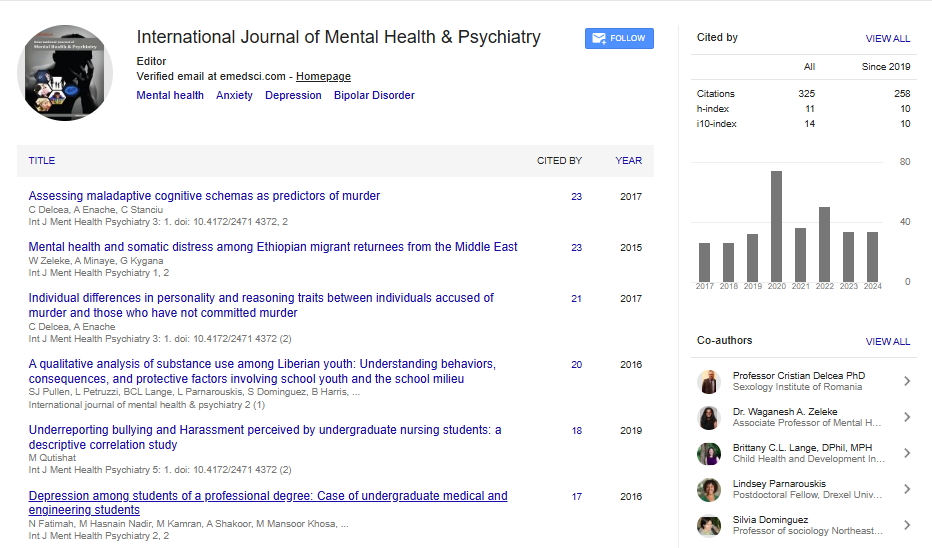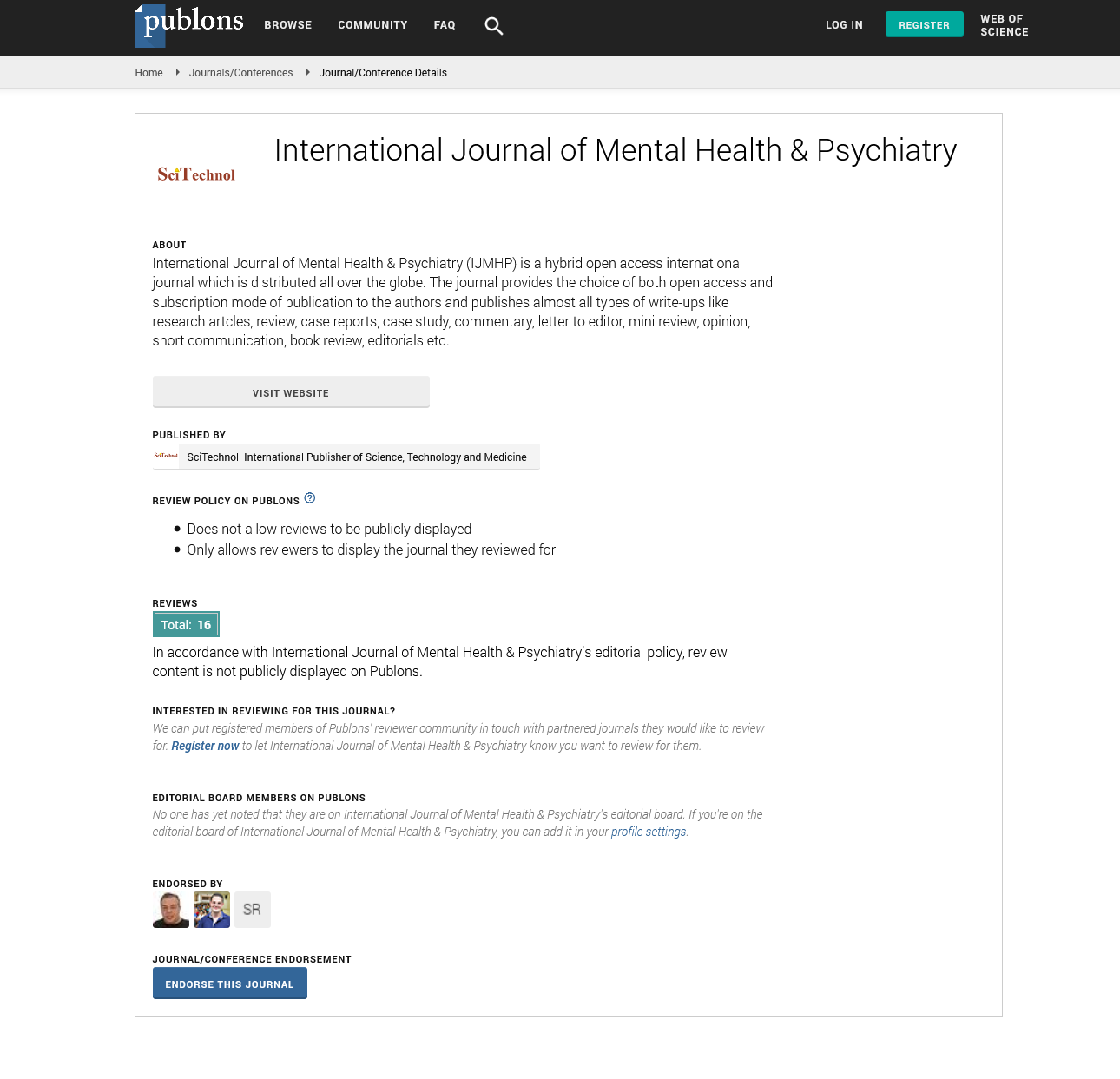Perspective, Int J Ment Health Psychiatry Vol: 10 Issue: 4
Child and Adolescent Psychiatry: Addressing Mental Health in the Early Years
Ramesh Gupta*
1Department of Child and Adolescent Psychiatry, University of Barcelona, Barcelona, Spain
*Corresponding Author: Ramesh Gupta,
Department of Child and Adolescent
Psychiatry, University of Barcelona, Barcelona, Spain
E-mail: guptar289@gmail.com
Received date: 26 November, 2024, Manuscript No. IJMHP-24-154316;
Editor assigned date: 28 November, 2024, PreQC No. IJMHP-24-154316 (PQ);
Reviewed date: 12 December, 2024, QC No. IJMHP-24-154316;
Revised date: 20 December, 2024, Manuscript No. IJMHP-24-154316 (R);
Published date: 27 December, 2024, DOI: 10.4172/2471-4372.1000276
Citation: Gupta R (2024) Child and Adolescent Psychiatry: Addressing Mental Health in the Early Years. Int J Ment Health Psychiatry 10:4.
Description
Child and adolescent psychiatry focuses on diagnosing, treating and preventing mental health issues in young individuals. This specialized field addresses the unique psychological and emotional challenges faced by children and teenagers, recognizing that their needs differ significantly from those of adults. Early intervention in mental health can profoundly influence a young person’s development and quality of life, making this discipline vital for cultivating healthier generations. Mental health issues in children and adolescents can arise from various factors, including genetics, family dynamics, environmental influences and traumatic experiences. Conditions such as anxiety disorders, depression, Attention-Deficit/Hyperactivity Disorder (ADHD) and Autism Spectrum Disorder (ASD) often emerge during childhood or adolescence. Addressing these issues early can mitigate their long-term effects and provide children with the tools to navigate life's complexities effectively.
Child and adolescent psychiatry encompasses a broad range of mental health conditions, focusing on the age-specific presentation of symptoms. Disorders such as Oppositional Defiant Disorder (ODD), conduct disorder and separation anxiety disorder frequently manifest during childhood. Adolescents, on the other hand, may be more susceptible to conditions like major depressive disorder, bipolar disorder and eating disorders such as anorexia nervosa and bulimia. Psychiatrists in this field employ various methods to diagnose and treat their patients. Comprehensive evaluations, including interviews with the child, family members and teachers, help produce a complete understanding of the child’s experiences. Standardized assessment tools and psychological testing are often utilized to support accurate diagnoses.
Therapeutic approaches and interventions
The treatment of mental health conditions in children and adolescents often involves a multidisciplinary approach. Psychiatrists work closely with psychologists, social workers, pediatricians and educators to design tailored treatment plans. Common interventions include:
Psychotherapy: Therapy forms the cornerstone of treatment. Cognitive-Behavioral Therapy (CBT) is particularly effective for conditions like anxiety and depression, while play therapy is suitable for younger children who may struggle with verbal expression.
Family therapy: This approach involves the entire family to address systemic issues and improve family dynamics, which play an essential role in a child's mental well-being.
Medication: In certain cases, psychiatrists may prescribe medications such as antidepressants, mood stabilizers, or stimulants to manage symptoms. Medication is typically considered a last resort, after weighing potential benefits and risks.
School-based interventions: Collaborating with educators to provide academic accommodations or behavioral support can be instrumental in ensuring the child’s success in school settings.
Moreover, the complex relationship of biological, psychological and social factors in young individuals makes diagnosis and treatment challenging. Symptoms may overlap with normal developmental behaviors and children often struggle to articulate their feelings, complicating the diagnostic process. Addressing mental health concerns early in life offers several benefits. Children and adolescents who receive appropriate treatment are more likely to develop spirit, build healthy relationships and succeed academically and socially. Early intervention can also prevent the progression of conditions into adulthood, reducing the burden of mental illness on individuals and society.
Promoting mental health awareness and integrating mental health education into schools can encourage early identification of issues. Training teachers and parents to recognize warning signs, such as changes in behavior, mood, or academic performance, can facilitate timely referrals to specialists. Advancements in research are continuously shaping the future of child and adolescent psychiatry. Emerging technologies, such as telepsychiatry and digital mental health tools, are improving access to care. Innovations in neurobiology and genetics are enhancing our understanding of mental health conditions, flagging the technique for more personalized treatment approaches.
Conclusion
In conclusion, child and adolescent psychiatry plays a precarious role in shaping the mental health landscape. By addressing the unique needs of young individuals, this field helps lay the foundation for healthier futures. Bridging gaps in access, reducing stigma and fostering collaborations between professionals, families and communities will ensure that every child and adolescent has the opportunity to thrive emotionally and psychologically.
 Spanish
Spanish  Chinese
Chinese  Russian
Russian  German
German  French
French  Japanese
Japanese  Portuguese
Portuguese  Hindi
Hindi 
